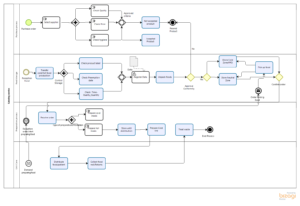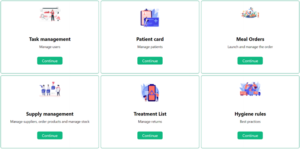Citation
Les auteurs
Kawtar RETMI
(kawtar.retmi@um6p.ma) - Research and education fellow at the institute of biological sciences, Mohammed VI Polytechnic UniversityFatima OUZAYD
(ouzayd@gmail.com) - Professor at Smart System Laboratory (SSLab), ENSIAS, Mohamed V UniversityCécile Godé
(cecile.gode@univ-amu.fr) - Aix-Marseille Université CERGAM - ORCID : https://orcid.org/0000-0002-9148-2820Btissam ENNAFAH
(btissam.ennaffah@um6p.ma) - Affiliate professor at the institute of biological science, Mohammed VI Polytechnic University
Copyright
Déclaration d'intérêts
Financements
Aperçu
Contenu
Digital technologies are fuelling the futuristic vision of a 100% digital hospital of tomorrow. Digital technologies bring automating repetitive tasks and structures information exchanges and the timing of healthcare activities (Geffroy et al., 2017). The immediate gain of hospital processes digitalization is costs optimization, decrease of information loss and redundancy, acceleration of communication between professionals, and better fluidity of the patient’s care path (Deloitte, 2018). It also improves the patient’s experience and quality of life (Gopal et al., 2019). Regarding extreme situations (Godé, 2010) hospitals used to face with since the COVID-19 outbreak, digitizing their supply chain became a priority to quickly deliver the right product to the right patient at the right time.
Improving healthcare delivery through digitalization entails providing product quality for patient well-being, in respect to hygiene and safety rules. This is the focus of this article which asks: How does digitalization support hygiene requirements in the hospital food supply chain? We are especially interested in the hospital catering supply chain, as it faced major challenges during the pandemic while nutritional care is supposed to play a key role during recovery from the virus. After reviewing logistics in hospital catering and its hygiene requirements, this article describes the digitalization modelling and design of a connected catering at the Benguerir hospital (Morocco).
Hygiene Requirement in Hospital Food Supply Chain: Insights from Hospital Catering
Hospital food supply chain is designed to provide nutrition to patients, from procurement to disposal, through waste management (Carino et al, 2020). It is considered as the most complex systems in hospitality industry, based on multiple stakeholders and services (Do Rosario, V., Walton, K., 2019). Regarding the latter,, it consists in different food services, including kiosks, fast-food outlets, and meal solutions served in workplace catering (Engelund et al., 2007).
Literature interested in hospital food supply chain provided very few works focus on hospital catering logistics. Existing research always associated such logistics with collective catering, where large quantities of food are prepared and served to groups of consumers – the elderly in retirement homes, children in canteens, sick in hospitals (Mezhoud, 2009) – and covers the services necessary for the preparation and delivery of meals to people working or living in communities, including health sector (hospitals, clinics, retirement homes) (Fassel, 2008).
The Covid 19 pandemic revealed the major role played by hospital catering logistics. It has been shown that an efficient food delivering process is essential to promote the health and nutritional status of patients (Do Rosario, V., Walton, K., 2019). This entails following severe hygiene requirements, depicted in Table 1.
Table 1. Hospital catering hygiene requirements

Digitalization of the Benguerir Hospital Catering
Research Settings
During the pandemic in Morocco, the lack of management, staff and equipment in public hospital has certainly contributed to the spread of the Covid-19, hospitals becoming incubators for the disease. Notably, at the hospital catering level, there was little practical clinical advice and knowledge for nutritional care and safety during recovery from the virus.
The town of Benguerir is endowed with a provincial hospital to strengthen local health structures and relieve pressure. In this context, a digitalization project of the Benguerir hospital catering has been carried out. The goal was to build a new catering area and automate catering processes, in order to support information reliability and provide product quality for patient well-being, in respect to hygiene and safety rules. The project mainly consists of modelling and designing the hospital information system restoration module by studying the different flows of the hospital food supply chain (from production / procurement to waste management / disposal) which provides food to patients, with no restrictions. The following describes the digitalization modelling and design of the connected catering at the Benguerir hospital.
Digital application modelling and design of the Benguerir Hospital Catering
We used BPMN 2.0 (Business Process Modelling Notation) to model the processes of the Benguerir hospital catering (see the methodological note for details). The goal of the hospital catering area was to provide food cooked according to acceptable hygiene requirements. Indeed, the culinary production requires a succession of operations from the purchase of food to the distribution of meals. The following figure 1 depicts an overview of the operational processes of hospital catering.
Figure 1. BPM modelling of the Benguerir hospital catering processes

Based on our BPMN model, we designed case diagrams needed to develop our application (see Figure 2 below). Our application is being tested, with a special focus on the below hygiene requirements and management. It offers a dedicated section related to hygiene rules, based on best practices of location, environment, and design of the hospital’s new connected catering space. The location of the premises has been studied to guarantee food safety. Particularly, they should be located at a great distance from polluted areas, prone to flooding and pest infestations. Consequently, the premises must be arranged in such a way as to allow the evacuation of solid or liquid wastes. Thus, the kitchen should never be used as a passage giving access to other parts of the building. A list of instructions has been drawn up to meet hygiene requirements at each level (floor, intermediate waste storage room, fuel reserve, etc.). Regarding management of different premises, they must be separated. Each room is assigned to one of the following operations: reception of raw materials, storage and conservation, local bins and organization of workspaces. Ideally, there should be two dedicated diving rooms or areas, one for heavy cooking utensils and another for trays. The two areas should be some distance from where the food is being prepared. In addition, hospitals must have suitable positive cold rooms and / or negative cold rooms, of sufficient capacity, equipped with measuring devices (direct reading thermometer) and a temperature alarm system. All these hygiene best practices are implemented in the digital catering application, “hygiene rules” section.
Figure 2. Front end of the digital catering application

Conclusion
To address the research question – How does digitalization support hygiene requirements in the hospital food supply chain? – this article described the modelling and design of a digital tool aims to automate key processes and streamline operations of a hospital catering service while supporting hygiene requirements. On the one hand, modelling (using BPM) of the hospital catering processes allowed grasping complexity and specificity of food operations. On the other hand, the technical solution design allowed us to manipulate new technologies to meet customer’s and professional needs. Regarding the latter, the application offers a dedicated section related to hygiene standards requirements.
Bibliographie
Carino, S., Porter, J., Malekpour, S., Collins, J., (2020). Environmental Sustainability of Hospital Foodservices across the Food Supply Chain: A Systematic Review. Journal of the Academy of Nutrition and Dietetics, 120(5), pp. 825–873. https://doi.org/10.1016/j.jand.2020.01.001
Deloitte (2018), Giving health care providers a digital edge: The case for digital supply networks, repéré à https://www2.deloitte.com/us/en/pages/operations/articles/health-care-building-a-digital-supply-chain-examples.html
Do Rosario, V., Walton, K., (2019). Hospital Food Service. In Meiselman, Herbert L. (Ed.), Handbook of Eating and Drinking, Springer, pp. 1007-1033. ISBN: 978-3-030-14503-3.
Engelund, H., Lassen, E., Mikkelsen, E. (2007). The modernization of hospital food service – findings from a longitudinal study of technology trends in Danish hospitals. Nutrition & Food Science, 37(2), pp. 90-99. https://doi-org.lama.univ-amu.fr/10.1108/00346650710736354
Fassel, V. (2008). Les ventes à la restauration collective : consommer local et biologique. Dans Gilles Maréchal (Ed.), Les circuits courts alimentaires : bien manger dans les territoires, Éducagri éditions, pp. 77-91. https://doi.org/10.3917/edagri.colle.2008.01.0077
Geffroy, B., de Corbière, F., Lairet, G., & Deltour, F. (2017). In search of flows synchronization: temporal and informational coordination of healthcare activities in a nuclear medicine unit. Systèmes d’Information et Management, 22(4), pp. 79-11, http://dx.doi.org/10.9876/sim.v22i4.796
Godé, C. (2010). Se coordonner en environnement volatil : les pratiques de coordination développées par les pilotes de chasse. Finance, Contrôle, Stratégie, 13(3), pp 61-93.
Gopal, G., Suter-Crazzolara, C., Toldo, L., Eberhardt, W., (2019). Digital transformation in healthcare – architectures of present and future information technologies. Clinical Chemistry and Laboratory Medicine, 57(3), pp. 328–335. https://doi.org/10.1515/cclm-2018-0658
Mezhoud, S. (2009) Gestion des risques microbiologiques en restauration collective (méthodes prédictives). Mémoire Post-graduation spécialisée, Filière Sciences Alimentaires et Nutrition, Option Alimentation, Nutrition et Santé, Repéré à http://archives.umc.edu.dz/bitstream/handle/123456789/12395/MEZ5388.pdf?sequence=1&isAllowed=y
